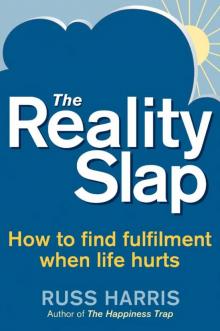- Home
- Russ Harris
The Reality Slap Page 20
The Reality Slap Read online
Page 20
mindfulness see presence (mindfulness)
‘Mindfulness of Sounds’ exercise 190
‘Mindfulness of the Breath’ exercise 209–11
mistakes 97–8, 126
N
‘Name Your Emotion’ exercise 85
naming
emotions exercise 85
stories 58, 93
thoughts 55–9
Neff, Kristin 107
negative thoughts 12, 27, 52–4, 92, 95
neutralisation techniques 59, 204–8
‘not good enough’ story 90–6, 121
author’s thoughts of son 194
envy and jealousy 114–17
labels 119–20
loneliness 117–18
perfectionism 126
‘Notice Your Emotion’ exercise 84–5
noticing
act of 23
of activity 55–9
art of 50–1
exercise 84–5
voice inside your head 43, 93–4
O
online resources 228
‘Open Up’ exercise 100
openess
connecting with 153
need for 172
opening up see expansion
opportunity, making use of 194
P
pain
acknowledging 15
being present (see presence (mindfulness))
controlling methods 73
finding the treasure beneath 14–15
as ‘gift’ 196–7
learning from 197–201
minimising 27–8
nature of 107
others’ response to 27–32
purpose and 140–9
past
accepting 168–9
judgement of 92
‘pause, breathe, notice and name’ exercise 93–4
perfectionism 126
physical afflictions, response to 82
playground experience 194
pleasure 215
positive thinking 22, 29, 52–3, 92, 95, 196
possessiveness 115–16
presence (mindfulness)
ACT meaning 5
act of caring 83
breathing into 125–6, 209–11
connection (see connection)
description 17–19
dropping the anchor 112
exercises 86–7, 98–104, 190, 192–3, 209–11
half-present 188
intimacy 172
meaningful activities 88
moments of 189–91
‘not good enough’ story 95–6
with pain 37
with people 192–3
with pleasure 193
practising 193–4
purpose and 132–3
with sounds 190
sustaining 125–6
values 215
‘Presence with People’
exercise 192–3
‘Presence with Pleasure’
exercise 193
‘privilege’ 20–3, 179–86
pro-active behaviour 72–3, 91
problem-solving 31, 94–5
procrastination 151
Ps, three see three Ps
purpose
actions v. thoughts 151–2
author’s own 133–5
clarifying 95–6
definition 19–20
identifying 131–9
love and 146–7
pain and 140–9
relationships and 147–9
R
reality, acknowledging 11
reality gap
closeability 121, 158
defined 1–4
feelings caused by 2
finding purpose 138–9
immediate response to 32
instant creation 90
life around the gap 180–2
mind’s reaction to 18–19
need for action 40–2
preparing for 141
‘purpose’ and 20
reacting with 121
self-defeating behaviour 97–8
situation causing 12–13
standing up to 156–7
strategies for closing (see closing the gap strategy)
regret, curiosity about 83
Relational Frame Theory (RFT) 164–5, 225
relationships with our body 152
with our job 154–5
with our mind 152
with ourselves 32
personal 153
presence in 195
purpose and 147–9
religion 60
resentment
curiosity about 83
entrapped by 167–71
resilience (‘Resilience Formula’) 157–66
Leave the Situation 157
Stay and Accept What Can’t Be Changed 159
Stay and Change What Can Be Changed 157–9
Stay and Give Up Trying 159–60
respect 137
responses, others’ 27–31
retreat 156
RFT (Relational Frame Theory) 164–5, 224–6
‘right’ 144
rules vs values 137–8
S
sadness
after significant loss 111–12
curiosity about 83
self-blame 34, 168–70
self-compassion
envy and jealousy 116
exercises 33–7, 42, 99–102, 103–4
finding 33–7
forgiveness 168–70
holding yourself kindly 13–14
kindness and presence 98–108
need for 32–3
practising 105
presence (see presence (mindfulness))
two main elements 37
self-criticism 13, 97–8
self-defeating behaviour 97–8
self-forgiveness 168–70
self-help
books 3
popular approaches to 13
self-kindness see self-compassion
self-regard 32
sensations
recognising 79–81
understanding 83–4
showering, mindful when 18
‘Silly Voices’ exercise 207
‘Singing’ exercise 208
Skinner, Burrhus Frederic 17, 21
‘Slow and Fast’ exercise 207
‘SMART’ goals 218
‘smoky haze’ 46–51
solitude 117
sorrow see sadness
space, creating 172
‘Speak Kindly’ exercise 101–2
spirituality
breathing and 60–1
as life value 216
‘Stay and Accept What Can’t
Be Changed’ 159
‘Stay, and Change What Can
Be Changed’ 157–9
‘Stay and Give Up Trying’ 159–60
Stevenson, Robert Louis 42
stillness 62
‘stories’ 44–5
author’s own 122–4
detaching from 53
explanation of term 44
naming 55–8, 93
‘not good enough’ (see ‘not good enough’ story)
strategy for closing the gap
see closing the gap
strategy
suffering see pain
suicide 131
support 216
support groups 196
survivor guilt 34
‘Sweet Spot’ exercise 142–3
T
‘Take a Breath’ exercises 61–2
‘Take a Stand’ strategy 14
‘taking a stand’ 157–9, 160–1
temper tantrums 66–7
thoughts
detachment from 53–4
naming 55–8
positive 22, 29, 52–3, 92, 95, 196
‘psychological smog’ 46–9
reaction to pain 19
relating to 150
strategies for relief 69
unhelpful 43–8
vs actions 150–1
see also mind; ‘stories’
‘Thoughts on Paper’ exercise 204–5
‘Three Cs’ 144–9, 151–5
‘Three Pillars of Love’ 146–7
‘three Ps’
dealing with death 23
exercises 183–5
presence 17–19
privilege 20–1
purpose 19–20
use of 21–3
timing of comments 31
training in ACT 229–30
treasuring life 14–15, 179–86
Twenty-two Blind Men and the Elephant story 4–5
U
understanding by others 31–2
urges 80
V
values
accepting what can’t be changed 159, 161
ACT meaning 5
author’s choices 162
clarifying 144–6, 212–17
goal-setting 158
identifying 217
purpose in life 20
understanding concept 136–9
virtues 144
visual neutralisation
techniques 204–7
W
willingness 161–2
Wilson, Kelly 141
work, relating to 152–5
workshops 229–30
‘wrong’ 144
Z
Zen masters 52

 The Reality Slap
The Reality Slap